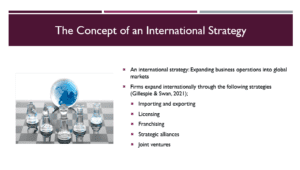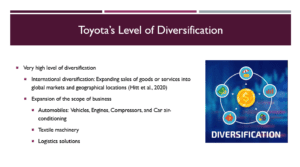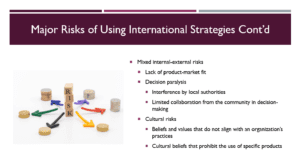The Global Environment – Toyota
Hello. Welcome to my presentation on Toyota Company’s global environment.
Toyota Company is a global automotive company that specializes in manufacturing and selling cars (GlobalData Plc., 2023). The company’s product line includes vans, crossovers, SUVs, pickup trucks, buses, and luxury vehicles.
An international strategy includes expanding business operations into global markets. According to Gillespie & Swan (2021), firms expand internationally through importing and exporting, licensing, franchising, strategic alliances, joint ventures, and direct investments. Exporting includes selling services or goods to other countries. Importing, on the other hand, includes purchasing goods and services from another country. Further, licensing comprises acquiring trademark rights, patent rights, know-how, copyrights, and processes from the international licensing firm. Franchising involves using another company’s trade name or trademark to distribute products, while strategic alliances include sharing resources with a company in the host country to create a mutually beneficial outcome. Lastly, joint ventures include sharing resources, profits, and risks with a company in the host country.
According to Ketchen et al. (2014), the main types of international strategies are multi-domestic, global, and transnational. The multi-domestic strategy includes sacrificing efficiency to respond to local requirements within every market and customizing products and services to meet the needs and preferences of customers in every local market. Second, the global strategy involves sacrificing responsiveness to local needs and preferences within every market to increase efficiency and offering similar products and services for every market to create economies of scale. Lastly, the transnational strategy includes creating a middle ground between a global and multi-domestic strategy. This is achieved by balancing the need for efficiency with the need to adjust to local preferences within every market.
Toyota Company has a very high level of diversification. The diversification includes international diversification and expansion of the scope of business. According to Hitt et al. (2020), international diversification includes expanding sales of goods or services into global markets and geographical locations. Toyota Company sells its products in countries worldwide, including developing and developed countries. Toyota Company has expanded its scope of business by venturing into manufacturing automobiles and automobile parts, including engines, compressors, and car air-conditioning. The company has also ventured into logistics solutions and manufacturing textile machinery.
The main incentives that can influence firms to use an international strategy include extending the product life cycle, gaining access to potentially scarce and needed resources, and gaining a competitive advantage. According to Hitt et al. (2016), international expansion facilitates knowledge transfer and innovation, leading to a competitive advantage. An international strategy expands the product life cycle by supporting the growth stage by increasing demand and expanding availability. The product life cycle includes the product introduction, growth, maturity, and decline stages. Supporting the growth stage is essential in increasing sales and product success in the market.
The main benefits of implementing an international strategy include increased market reach, increased motivation, and high competitive advantage. According to Panibratov (2017), an international strategy enables organizations to reach more potential customers, thus expanding their market reach. An international strategy also enables organizations to access different demographics influenced by different values, beliefs, and economic standards and new ideas and viewpoints that increase innovation. Organizations gain a competitive advantage from an international strategy by acquiring a large customer base and gaining increased brand awareness.
The major risks of using international strategies include internal risks and external risks. According to Sibyl (2020), internal risks include the risk of over or under-investing and opportunity cost risk. Opportunity cost risk may arise when the returns gained from expanding into the global market are less compared to what the company makes in its local markets. External risks include geopolitical and macroeconomic risks such as taxation changes, trade disputes, political instability, legislative risks, and competition. Legislative risks emerge from changes in laws impacting business operations. Finally, competition may arise from local and international firms offering similar products and services.
Another type of risk associated with using international strategies is mixed internal-external risks. The risks under this category include lack of product-market fit, decision paralysis, and cultural risk. Notably, decision paralysis arises from local authorities’ interferences and limited community collaboration in decision-making. Conversely, cultural risks emerge when the beliefs and values do not align with an organization’s practices and when cultural beliefs prohibit using specific products.
Companies are expanding their operations into global markets to create a competitive advantage. Toyota has integrated its international strategy into its diversification strategy. Notably, it has a high level of diversification characterized by international diversification and expansion of the scope of business. An international strategy includes multi-domestic, global, and transnational strategies. Accordingly, the main benefits of using an international strategy include increased market reach, innovation, and brand awareness. Nonetheless, an international strategy is associated with 1) internal risks, such as the risk of over or under-investing and opportunity cost risk; 2) external risks, such as geopolitical and macroeconomic risks; 3) legislative risks; and 4) competition and mixed internal-external risks, such as lack of product-market fit, decision paralysis, and cultural risks.
References
Gillespie, K., & Swan, K. S. (2021). Global market entry strategies. Global Marketing, 260–288. https://doi.org/10.4324/9781003141709-9
GlobalData Plc. (2023). Toyota Motor Corp Company Profile – Overview. GlobalData. https://www.globaldata.com/company-profile/toyota-motor-corp/
Hitt, M. A., Ireland, R. D., & Hoskisson, R. E. (2020). Strategic management: Competitiveness and globalization. South-Western Cengage Learning.
Hitt, M. A., Li, D., & Xu, K. (2016). International strategy: From local to global and beyond. Journal of World Business, 51(1), 58–73. https://doi.org/10.1016/j.jwb.2015.08.016
Ketchen, D., Short, J., Try, D., & Edwards, J. (2014, September 12). Types of international strategies. Mastering Strategic Management 1st Canadian Edition. https://opentextbc.ca/strategicmanagement/chapter/types-of-international-strategies/
Panibratov, A. (2017). International Strategy of Emerging Market Firms. https://doi.org/10.4324/9781315696669
Sibyl. (2020, March 6). 12 risks of Global Business Expansion. Sibyl. https://www.sibylentertainment.com/12-risks-of-global-business-expansion/
ORDER A PLAGIARISM-FREE PAPER HERE
We’ll write everything from scratch
Question

The Global Environment – Toyota
The Company I have chosen is Toyota.
Based on the company selected, explain the following questions:
– Explain incentives that can influence firms to use an international strategy (corporate and business level strategies).
– Explain the level of diversification (notes are posted in the module for reference) used by the company.
– Are there any risks associated with the company using the strategy? Explain why or why not.













